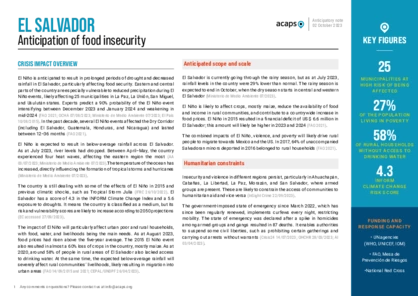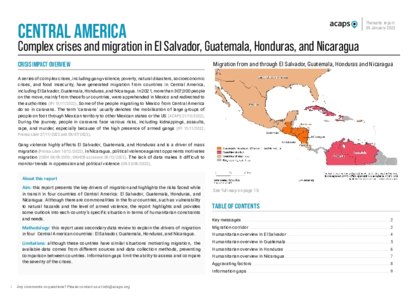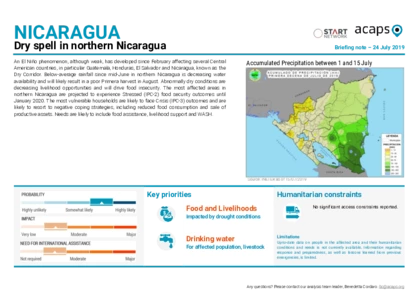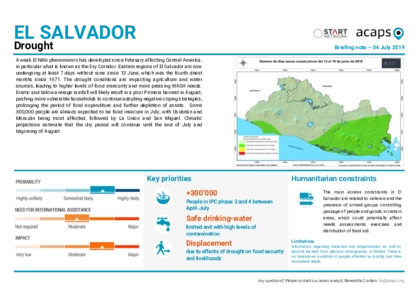current crises
in
El Salvador
These crises have been identified through the INFORM Severity Index, a tool for measuring and comparing the severity of humanitarian crises globally.
SLV001 - Political and Economic crisis
Last updated 28/11/2025
Drivers
Political/economic crisis
Crisis level
Country
Severity level
2.9 Medium
Access constraints
1.0
Analysis products
on
El Salvador
02 October 2023
El Salvador: anticipation of food insecurity
DOCUMENT / PDF / 316 KB
El Niño is anticipated to result in prolonged periods of drought and decreased rainfall in El Salvador, particularly affecting food security. Eastern and central parts of the country are especially vulnerable to reduced precipitation during El Niño events, likely affecting 25 municipalities in La Paz, La Unión, San Miguel, and Usulután states.
05 January 2023
Central America: Complex crises and migration
DOCUMENT / PDF / 1 MB
This report presents the key drivers of migration and highlights the risks faced while in transit in four countries of Central America: El Salvador, Guatemala, Honduras, and Nicaragua. Although there are commonalities in the four countries, the report highlights and provides some outlook into each country’s specific situation in terms of humanitarian constraints and needs.
Attached resources
24 July 2019
Nicaragua: Dry spell in the north
DOCUMENT / PDF / 502 KB
An El Niño phenomenon, although weak, has developed since February affecting several Central American countries, in particular Guatemala, Honduras, El Salvador and Nicaragua, known as the Dry Corridor. The most vulnerable households are likely to face Crisis (IPC-3) outcomes and are likely to resort to negative coping strategies, including reduced food consumption and sale of productive assets. Needs are likely to include food assistance, livelihood support and WASH.
01 July 2019
El Salvador: Drought
DOCUMENT / PDF / 533 KB
A weak El Niño phenomenon has developed since February affecting Central America, in particular what is known as the Dry Corridor. The drought conditions are impacting agriculture and water sources, leading to higher levels of food insecurity and more pressing WASH needs.
29 October 2018
Guatemala: Migrant Caravan
DOCUMENT / PDF / 291 KB
Since 13 October, several thousand migrants have left Honduras, El Salvador and Guatemala to form two large caravans and multiple smaller groups travelling by foot towards the United States border. Protection concerns, as well as, urgent food, water and shelter needs, have been reported.






